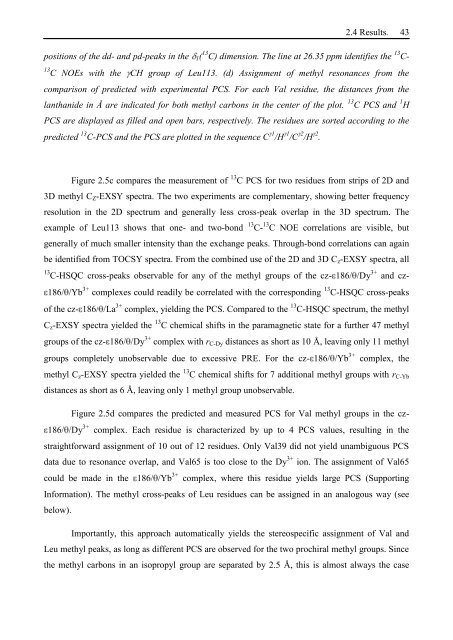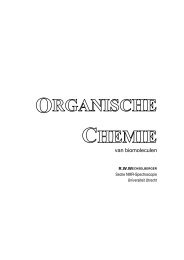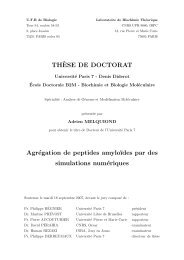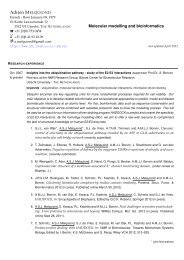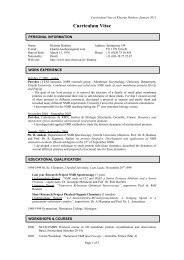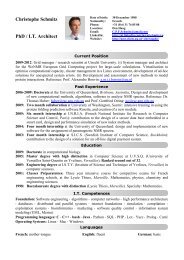Thesis Title: Subtitle - NMR Spectroscopy Research Group
Thesis Title: Subtitle - NMR Spectroscopy Research Group
Thesis Title: Subtitle - NMR Spectroscopy Research Group
You also want an ePaper? Increase the reach of your titles
YUMPU automatically turns print PDFs into web optimized ePapers that Google loves.
2.4 Results. 43<br />
positions of the dd- and pd-peaks in the 1( 13 C) dimension. The line at 26.35 ppm identifies the 13 C-<br />
13 C NOEs with the CH group of Leu113. (d) Assignment of methyl resonances from the<br />
comparison of predicted with experimental PCS. For each Val residue, the distances from the<br />
lanthanide in Å are indicated for both methyl carbons in the center of the plot. 13 C PCS and 1 H<br />
PCS are displayed as filled and open bars, respectively. The residues are sorted according to the<br />
predicted 13 C-PCS and the PCS are plotted in the sequence C 1 /H 1 /C 2 /H 2 .<br />
Figure 2.5c compares the measurement of 13 C PCS for two residues from strips of 2D and<br />
3D methyl CZ-EXSY spectra. The two experiments are complementary, showing better frequency<br />
resolution in the 2D spectrum and generally less cross-peak overlap in the 3D spectrum. The<br />
example of Leu113 shows that one- and two-bond 13 C- 13 C NOE correlations are visible, but<br />
generally of much smaller intensity than the exchange peaks. Through-bond correlations can again<br />
be identified from TOCSY spectra. From the combined use of the 2D and 3D Cz-EXSY spectra, all<br />
13 C-HSQC cross-peaks observable for any of the methyl groups of the cz- 186/ /Dy 3+ and cz-<br />
186/ /Yb 3+ complexes could readily be correlated with the corresponding 13 C-HSQC cross-peaks<br />
of the cz- 186/ /La 3+ complex, yielding the PCS. Compared to the 13 C-HSQC spectrum, the methyl<br />
Cz-EXSY spectra yielded the 13 C chemical shifts in the paramagnetic state for a further 47 methyl<br />
groups of the cz- 186/ /Dy 3+ complex with rC-Dy distances as short as 10 Å, leaving only 11 methyl<br />
groups completely unobservable due to excessive PRE. For the cz- 186/ /Yb 3+ complex, the<br />
methyl Cz-EXSY spectra yielded the 13 C chemical shifts for 7 additional methyl groups with rC-Yb<br />
distances as short as 6 Å, leaving only 1 methyl group unobservable.<br />
Figure 2.5d compares the predicted and measured PCS for Val methyl groups in the cz-<br />
186/ /Dy 3+ complex. Each residue is characterized by up to 4 PCS values, resulting in the<br />
straightforward assignment of 10 out of 12 residues. Only Val39 did not yield unambiguous PCS<br />
data due to resonance overlap, and Val65 is too close to the Dy 3+ ion. The assignment of Val65<br />
could be made in the 186/ /Yb 3+ complex, where this residue yields large PCS (Supporting<br />
Information). The methyl cross-peaks of Leu residues can be assigned in an analogous way (see<br />
below).<br />
Importantly, this approach automatically yields the stereospecific assignment of Val and<br />
Leu methyl peaks, as long as different PCS are observed for the two prochiral methyl groups. Since<br />
the methyl carbons in an isopropyl group are separated by 2.5 Å, this is almost always the case


